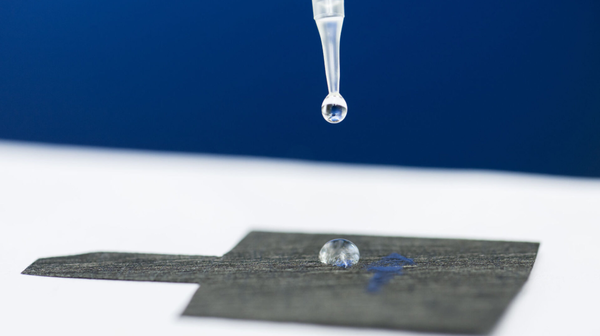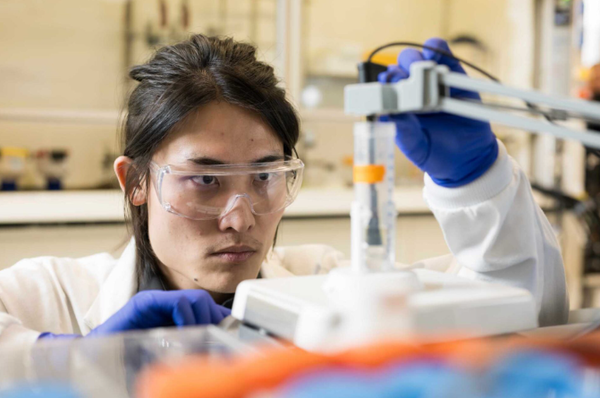[미국] 로체스터대 연구팀, 전기 촉매 방식 활용 물에서 ‘PFAS’ 제거
‘영원한 화학물질’ 오염 정화하기 위한 새로운 전기화학적 접근법 개발
촉매 분야 권위지 『저널 오브 커탤러시스(Journal of Catalysis)』 최근호에 게재

로체스터대 연구팀은 PFOS(Perfluorooctane sulfonate)라고 불리는 특정 유형의 PFAS를 보다 경제적으로 제거할 수 있는 나노 촉매를 개발했다 [사진출처 = University of Rochester]
로체스터 대학교(University of Rochester)의 연구팀은 의류, 식품 포장재, 포 소화약제 및 기타 다양한 제품에서 발견되는 ‘영원한 화학 물질’로 인한 오염을 정화하기 위한 새로운 전기화학적 접근법을 개발했다. 새로운 연구는 촉매 분야 권위지인 『저널 오브 커탤러시스(Journal of Catalysis)』에 게재됐으며, PFAS로 알려진 과불화합물을 제거하기 위해 개발된 나노 촉매에 대해 설명한다.
아스트리드 뮐러(Astrid Müller) 화학공학과 조교수가 이끄는 연구팀은 한때 얼룩 방지 제품에 널리 사용됐지만 현재 유해성으로 인해 전 세계 대부분의 지역에서 사용금지된 PFOS(Perfluorooctane sulfonate)라는 특정 유형의 PFAS 연구에 초점을 맞췄다.
PFOS는 2000년대 초반에 미국 제조업체에 의해 단계적으로 폐지됐음에도 여전히 환경에 널리 퍼져 있으며, 상수도에서 지속적으로 나타나고 있다.

재료과학 박사과정 학생 Ziyi ‘Bruce’ Meng은 로체스터대에서 개발된 새로운 전기 촉매 기술이 PFOS 오염을 얼마나 효과적으로 개선하는지 알아보기 위해 물 샘플을 테스트하고 있다 [사진출처 = University of Rochester]
뮐러와 재료과학 박사과정 학생으로 구성된 팀은 초고속 레이저, 재료과학, 화학, 화학공학 분야의 전문 지식을 활용해 나노 촉매를 개발했다.
뮐러는 “액체 합성에 펄스 레이저를 사용하면 기존의 습식화학 방법으로는 할 수 없는 방식으로 촉매의 계면화학을 제어할 수 있다”라며 “빛과 물질의 상호작용을 통해 나노 입자의 크기를 조절할 수 있으며, 기본적으로 분해할 수 있다”고 말했다.
연구팀은 나노 입자를 친수성이거나 물 분자에 끌리는 탄소 종이에 부착한다. 이는 표면적이 넓은 저렴한 기판의 역할을 한다. 이후 고농도의 수산화리튬을 사용해 PFOS를 완전히 탈불소화했다.

로체스터대 연구팀은 친수성 탄소 종이에 부착된 레이저로 만든 나노 촉매를 사용해 PFOS 오염을 개선하는 저렴하고 효과적인 방법을 개발했다. 사진은 탈불소화 진행 모습 [사진출처 = University of Rochester]
뮐러는 이 공정이 대규모로 작동하려면 한 번에 최소 1㎥를 처리해야 한다고 말했다. 특히 연구팀의 새로운 방식은 붕소가 첨가된 다이아몬드를 필요로 하는 기존 방법과 달리 모든 비귀금속을 사용할 수 있다. 연구팀에 따르면, 붕소가 첨가된 다이아몬드를 사용해 오염된 물 1㎥를 처리하는 데 850만 달러가 들지만 새로운 방법은 이보다 약 100배 더 저렴하다.
지속 가능한 방식으로 PFAS 화학물질 활용
향후 연구에서 뮐러는 수산화리튬이 왜 그렇게 잘 작동하는지, 또한 비용을 더 낮추기 위해 더 저렴하고, 풍부한 재료로 대체할 수 있는지 연구할 계획이다.
뮐러는 “모든 PFAS 화학물질을 전면 금지하는 것은 소비재뿐만 아니라 친환경 기술에서도 유용하기 때문에 실용적이지 않다”고 말한다.
뮐러는 “지열 펌프와 효율적인 냉각, 태양 전지에 이르기까지 많은 탈탄소화 노력이 PFAS의 가용성에 달려 있다”며 “전기 촉매 용액을 활용해 플루오르카본과 결합을 끊고, 불소를 환경에 버리지 않고 안전하게 다시 회수할 수 있다면 PFAS를 순환적이고 지속 가능한 방식으로 사용할 수 있다고 생각한다”고 말했다.
[원문보기]
Harmful ‘forever chemicals’ removed from water with new electrocatalysis method
A novel approach using laser-made nanomaterials created from nonprecious metals could lay the foundation for globally scalable remediation techniques.
Scientists from the University of Rochester have developed new electrochemical approaches to clean up pollution from “forever chemicals” found in clothing, food packaging, firefighting foams, and a wide array of other products. A new Journal of Catalysis study describes nanocatalysts developed to remediate per- and polyfluoroalkyl substances, known as PFAS.
The researchers, led by assistant professor of chemical engineering Astrid Müller, focused on a specific type of PFAS called Perfluorooctane sulfonate (PFOS), which was once widely used for stain-resistant products but is now banned in much of the world for its harm to human and animal health. PFOS is still widespread and persistent in the environment despite being phased out by US manufacturers in the early 2000s, continuing to show up in water supplies.
Müller and her team of materials science PhD students created the nanocatalysts using her unique combination of expertise in ultrafast lasers, materials science, chemistry, and chemical engineering.
“Using pulsed laser in liquid synthesis, we can control the surface chemistry of these catalysts in ways you cannot do in traditional wet chemistry methods,” says Müller. “You can control the size of the resulting nanoparticles through the light-matter interaction, basically blasting them apart.”
The scientists then adhere the nanoparticles to carbon paper that is hydrophilic, or attracted to water molecules. That provides a cheap substrate with a high surface area. Using lithium hydroxide at high concentrations, they completely defluorinated the PFOS chemicals.
Müller says that for the process to work at a large scale, they will need to treat at least a cubic meter at a time. Crucially, their novel approach uses all nonprecious metals, unlike existing methods that require boron-doped diamond. By their calculations, treating a cubic meter of polluted water using boron-doped diamond would cost $8.5 million; the new method is nearly 100 times cheaper.
Harnessing PFAS chemicals in sustainable ways
In future studies, Müller hopes to understand why lithium hydroxide works so well and whether even less expensive, more abundant materials can be substituted to bring the cost down further. She also wants to apply the method to an array of PFAS chemicals that are still prevalently used but have been linked to health issues ranging from development in babies to kidney cancer.
Müller says that despite their issues, outright banning all PFAS chemicals and substances is not practical because of their usefulness in not only consumer products, but in green technologies as well.
“I would argue that in the end, a lot of decarbonization efforts—from geothermal heat pumps to efficient refrigeration to solar cells—depend on the availability of PFAS,” says Müller. “I believe it’s possible to use PFAS in a circular, sustainable way if we can leverage electrocatalytic solutions to break fluorocarbon bonds and get the fluoride back out safely without putting it into the environment.”
Although commercialization is a long way off, Müller filed a patent with support from URVentures, and foresees it being used at wastewater treatment facilities and by companies to clean up contaminated sites where they used to produce these PFAS chemicals. She also calls it a social justice issue.
“Often in areas with lower income across the globe, there’s more pollution,” says Müller. “An advantage of an electrocatalytic approach is that you can use it in a distributed fashion with a small footprint using electricity from solar panels.”
[출처 = University of Rochester(https://www.rochester.edu/newscenter/pfas-chemicals-in-water-electrocatalysis-method-596532/) /2024년 3월 5일]
[논문출처 = 『저널 오브 커탤러시스(Journal of Catalysis)』(https://www.sciencedirect.com/science/article/pii/S0021951724001167)]
| 











































